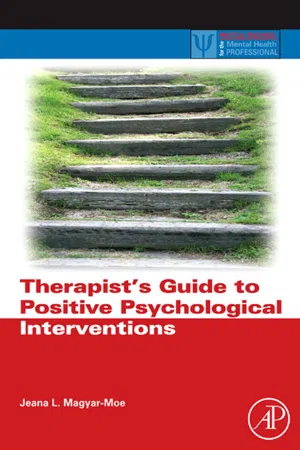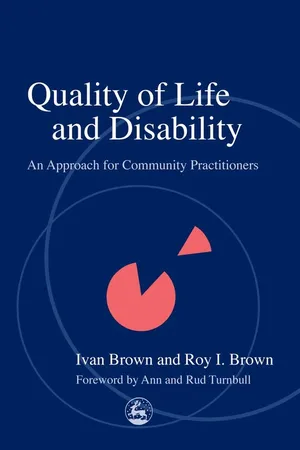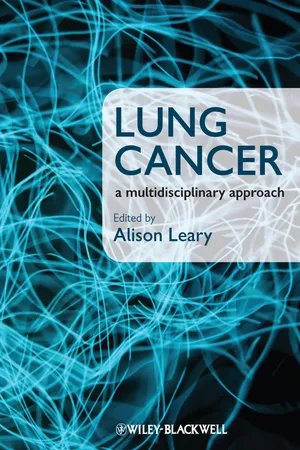Psychology
Quality of Life Therapy
Quality of Life Therapy is an approach that focuses on enhancing an individual's overall well-being and satisfaction with life. It emphasizes the importance of addressing physical, emotional, social, and spiritual aspects of life to improve quality of life. This therapy aims to help individuals identify and pursue meaningful goals, leading to a more fulfilling and satisfying life.
Written by Perlego with AI-assistance
Related key terms
Related key terms
1 of 4
Related key terms
1 of 3
7 Key excerpts on "Quality of Life Therapy"
- Jeana L. Magyar-Moe(Author)
- 2009(Publication Date)
- Academic Press(Publisher)
4. Did you experience a sense of meaning or connection to something larger than yourself through this activity? Please briefly explain your response to this question below.In the 14th and final session of Positive Psychotherapy, the full life is discussed (see the explanation of the full life as described previously in this chapter). Clients are asked to come to this session having re-taken the Positive Psychotherapy inventory (see Worksheet 4.4 ) which is discussed in comparison to the results from this measure taken earlier at session 2. Discussion of any homework assignments that were not previously reviewed takes place and the progress or gains made throughout the Positive Psychotherapy sessions are made explicit. Finally, therapists provide clients with a plan for maintaining or continuing to strengthen the skills and lessons learned throughout this treatment regimen (Rashid, 2008 ).4.1.4. Quality of Life Therapy
Quality of Life Therapy has been described as a comprehensive approach to blending the tenets of positive psychology with cognitive therapy in order to help clients discover and proceed toward their needs, goals, and wishes in important areas of life in order to live a life of quality and satisfaction (Frisch, 2006 ). Indeed, Quality of Life Therapy is so comprehensive that all of the components of this treatment approach cannot be explained within the context of this text. However, an overview is provided and those therapists interested in learning more about Quality of Life Therapy can refer directly to Frisch (2006) for more details.Quality of Life Therapy emphasizes a whole life or life goal perspective (Frisch, 2006 ). More specifically, at each stage of treatment a direct connection is made between the client’s life goals, needs, and wishes and the interventions being used. In addition, clients are conceptualized in a complete way that incorporates both their strengths and weaknesses in 16 areas of everyday life functioning as well as any actual psychopathology they may be experiencing. Table 4.4 includes the 16 areas of life functioning that are major foci of this treatmentapproach and can be measured using the Quality of Life Inventory (QOLI; Frisch, 1994- eBook - ePub
Quality of Life and Disability
An Approach for Community Practitioners
- Roy Brown, Ivan Brown(Authors)
- 2003(Publication Date)
- Jessica Kingsley Publishers(Publisher)
Quality of life is ever-changing. Quality of life can change from year to year, and even from day to day. Any number of planned and unplanned events can occur to change the quality of a person’s life. In addition, as we move through life, we have different priorities and value different things. Thus, the things that contribute to an individual’s quality of life at one stage may be quite different from those that contribute to it later on. In other words, there is also variability within each individual over time.What does a quality of life approach achieve?
When we use a quality of life approach, we focus specifically on six key application principles to build upon the five essential ideas described above. The quality of life approach:1. Focuses attention on the processes that are most important to the person at the present time; this includes those things that the person shares with other humans and those things that are more individually valued by the person and relevant to his or her life.2. Works to ensure that the person is satisfied with those aspects of life that are important, and not dissatisfied with other aspects of his or her life; human beings are never fully satisfied with all aspects of their lives, and this characteristic keeps us striving for improvement; in taking a quality of life approach, we strive for feeling quite well satisfied overall, and for feeling much more satisfaction than dissatisfaction in our lives.3. Stresses that opportunities to improve must be within the person’s grasp.4. Insists that personal choice should be exercised, wherever possible, in selecting opportunities.5. Improves the person’s self-image.6. Increases levels of personal empowerment.Final words
In this chapter, we have introduced you to a quality of life approach. We have learned what quality of life means, who can use this approach, and the basic ideas needed for helping people improve their lives.For thought and discussion
1. Are all people entitled to lives of quality?2. Look back at the three-level framework again. Think of a time in your life when each of the levels was particularly important to you.3. - eBook - ePub
- Ad Vingerhoets, Ad Vingerhoets(Authors)
- 2013(Publication Date)
- Routledge(Publisher)
16Quality of Life Assessment Jolanda de VriesThe focus of this chapter will be on the assessment of quality of life (QOL). According to the World Health Organisation Quality of Life group, QOL should be defined as “a person’s perception of his/her position in life within the context of the culture and value systems in which s/he lives and in relation to his/her goals, expectations, standards, and concerns. It is a broad-ranging concept incorporating, in a complex way, the person’s physical health, psychological state, level of independence, social relationships, personal beliefs, and relationship to salient features of the environment” (WHOQOL group, 1994, p. 28).This definition reflects the view that QOL refers to a subjective evaluation which is embedded in a cultural, social, and environmental context. Although some researchers have already noted these aspects, it is the first time that they have been incorporated into a definition. Moreover, QOL is a very broad multidimensional concept, going beyond the WHO’s definition of health which states that health is “a state of complete physical, mental, and social well-being and not merely the absence of disease of infirmity” (WHO, 1958). For this same reason, QOL cannot simply be equated with terms like functional status or health status, mental state, or well-being. As Ware (1991, p. 776) has put it: “It has become fashionable to talk about functional status and well-being as if they were synonymous with quality of life. Quality of life, however, is a much broader concept.”Many measures are claimed to assess QOL. However, strictly speaking, these often concern health status measures that focus on the influence of disease on a person’s physical, psychological, and social functioning. Health status measures are only subjective in the sense that they are completed by patients themselves. In contrast, QOL measures, besides being completed by patients, are subjective in the sense that patients are also asked to evaluate the aspects of QOL (e.g., “How satisfied …?”/“How bothered …?”). - eBook - ePub
Physical Environments and Aging
Critical Contributions of M. Powell Lawton to Theory and Practice
- Paul Windley, Rick Scheidt(Authors)
- 2015(Publication Date)
- Routledge(Publisher)
A definition of quality of life may be offered here: Quality of life is the multi-dimensional evaluation, by both intrapersonal and social-normative criteria, of the person-environment system of an individual in time past, current, and anticipated. (Lawton, 1991, p. 6)In a series of my own research findings, there has been a strong tendency for positive emotional states to occur in older people who are more engaged with other people, leisure activities, and their environments. One of my current ideological missions is to promote the idea that a neglected route to positive mental health for older people is to find ways of enhancing such engagement. A much more difficult idea for research is whether there are other extroverted means by which people can enhance their engagement with their own goals, thoughts, or memories … ways of making one’s interiority more novel, challenging, and appealing, as perhaps in self-guided reminiscence, is a task for future clinician. [italics added] (Lawton, 2000, pp. 192-193)The fundamental premise of Powell Lawton’s (1991) conceptualization of “quality of life” is recognition of the breadth and depth of older adults’ lives and the inherent meanings. This conceptual model appreciates the complexity of the concept and provides a systemic approach in understanding the person, as well as emphasizes the importance of socio-psychological aspects in life beyond the traditional approaches that look at decrements from a baseline. Lawton’s (1991) quality of life conceptualization proposes four evaluative sectors of “good life”: psychological well-being, perceived quality of life, behavioral competence and objective environment. At the core of these four sectors is “self” as the integrating reality of individuals. For example, quality of life gains added dimensions in the long-term care setting as older adults become part of and subject to organizational policies, care philosophies and regulations. Issues of personal choice, interaction with staff members, dependence, self-esteem, etc., have a profound significance because for many people this will be their “residence” for the balance of their lives. - Alex M. Wood, Judith Johnson, Alex M. Wood, Judith Johnson(Authors)
- 2016(Publication Date)
- Wiley-Blackwell(Publisher)
While her Beck Depression Inventory-II was in the nonclinical or low range at post-treatment, her overall score on the Quality of Life Inventory, was also in the low range, signifying a lack of fulfillment in some highly valued areas of life; B’s QOLI test results are presented in Figure 27.1. These assessment results brought to mind David A. Clark’s (2006) rationale for adding positive psychology to traditional psychotherapies, to wit: In some respects, clinical psychology and psychiatry have exhibited a depressive thinking style in their theories, research, and treatment of psychological disorders. We have tended to focus exclusively on the negative. Our preoccupation has been the relief of suffering, the alleviation of negative emotions, the restructuring of negative cognitions and dysfunctional schemas, and the modification of problematic behavioral responses … As psychotherapists, we have ignored the “half-full” side of the equation. That is, we rarely address issues of happiness, contentment, and quality of life. At last psychologists like Ed Diener, Martin Seligman, and Michael B. Frisch have begun to readdress this imbalance in our perspective on human emotion … Treating negative mood will not automatically lead to happiness and life satisfaction in our patients. Instead a new and expanded therapeutic perspective is needed that directly addresses issues of positive affect, life satisfaction, and contentment. (Clark, 2006, p. ix, italics added) Based on this rationale, QOLT was instituted in an effort to boost B’s positive affect experience and satisfaction with life (QOLT can also be implemented concurrently with a psychotherapy and/or pharmacotherapy; see Furey (2007) and Frisch (2006) for guidelines on how to do this). B was excited and motivated by the prospect of learning ways to be happier and more enthusiastic about her life. She also was intrigued by the part of the rationale that promised a prophylactic effect from QOLT- eBook - ePub
Designs for Living
A Comparative Approach to Normalisation for the New Millennium
- Steven Carnaby(Author)
- 2018(Publication Date)
- Routledge(Publisher)
One way of tackling the complexities of quality of life research is to understand its origins. Studying quality of life in the learning disability field has its foundation in many other disciplines. There are studies which look at the effect of policy on the lives of specific groups of people, using an index of measures which give an overall but implicit “sense” of their quality of life. More recent research has tried to stop avoiding the difficult question of what is meant precisely by “quality of life”, and has begun to recognise the weaknesses of earlier work which failed to provide any workable definitions.It is generally accepted that the root of modern research is Thomdike’s (1939) study of the quality of life in American cities; this used social indicators to assess a broad view of life in an American community. Other fields that have used quality of life when studying service delivery are gerontology (e.g. Adams 1941), head-injury (e.g. Klonoff et al 1986), and mental illness (e.g. Lehman 1983).Economic considerations became paramount in the last decade, as Government sought to constrain public expenditure, and health economists began to look at how they could evaluate medical procedures in terms of their monetary efficiency (Drummond 1981).Ethical issues were raised when approaches recommending that less financially demanding practices should receive a higher percentage of available funding in order to increase the total number of life years gained (Zaner 1986). Critics argued that such approaches assume that all life-years afford an equal level of quality of life. This failure to account for quality in any meaningful context led to the introduction of Quality of Life adjusted years (QALY’s); essentially, a year of healthy life expectancy is equivalent to ‘one’, whereas a year of unhealthy life expectancy is ‘less than one’ (Williams 1979). QALY’s are used in a similar way to the analysis of medical procedures (Drummond 1981), in that they are utilised as evidence of cost-effectiveness for specific medical interventions or techniques, as well as for determining who should be treated. Understandably, QALY’s have been criticised for being too simplistic (e.g. Loomes & McKenzie 1989) and ethically undesirable, as they focus on time rather than the life of an individual (e.g. Harris 1987). One can see how such thinking could also provide substance both for the abortion debate and for the adoption of foetal scanning. - eBook - ePub
Lung Cancer
A Multidisciplinary Approach
- Alison Leary, Alison Leary(Authors)
- 2011(Publication Date)
- Wiley-Blackwell(Publisher)
Quality of life is apparent in two contexts: authors seek either to define quality of life or to measure quality of life. This may seem a logical path to take, but it means that the literature lacks integration. For example, this fragmentation makes it difficult for a clinician to introduce quality of life assessment into practice without in-depth exploration of the two areas, unless a formulaic approach is used. This is exactly the situation at present and explains the dominance of questionnaires and quality-of -life tools in practice, particularly in the context of health economics. The definition from the Oxford English Dictionary (1995) of quality of life as ‘… a vague and ethereal entity’ serves to illustrate the difficulty in attempting to define quality of life and illustrates the difficulty also faced by the researcher in this area in trying to find that definition. When quality of life has been discussed in the literature, it has usually been in terms that vary widely from the ‘need-based’ theories of authors such as Maslow (Maslow 1954) to expressions of the value or excellence of life and the word ‘quality’ being used in an evaluative sense (Meeberg 1993). Scholars argue that this is such an enormous area of study that it is almost impossible to define quality of life (Stegbaur 1994). This was also true in application of the term quality of life.Quality of life is a multilevel concept reflecting macrosocietal and sociodemographic influences and also the micro concerns of individuals’ experiences, circumstances, health, social well-being, values, perceptions and psychology (Bowling et al . 2003). Quality of life became a focus for nursing practice in the 1980s and, as more definitions emerged, the concept receded (Mast 1995). It is possible that as nursing has evolved with such rapidity, many terms have become ambiguous. Quality of life is of particular interest to nurses and nurse researchers because much value is placed on the evaluation of nursing interventions and quality of life could be perceived as an outcome measure. This is demonstrated by the liberal use of the term ‘quality of life’ in the nursing literature. The Oncology Nursing Society, for example, cited ‘quality of life’ as among its top three priorities, without definition (Stetz et al . 1995).Incidence, survival and mortality have historically been used to map cancer pathology and success of treatment (Fraumen et al
Index pages curate the most relevant extracts from our library of academic textbooks. They’ve been created using an in-house natural language model (NLM), each adding context and meaning to key research topics.
Explore more topic indexes
Explore more topic indexes
1 of 6
Explore more topic indexes
1 of 4






